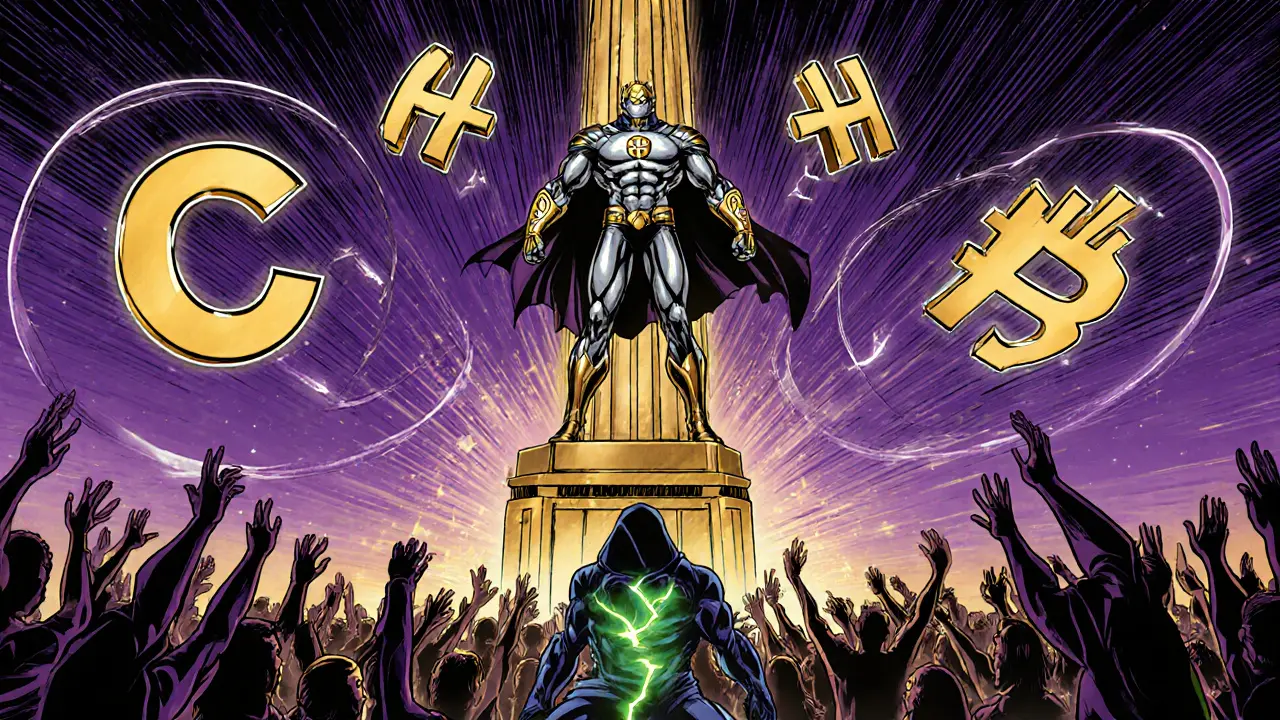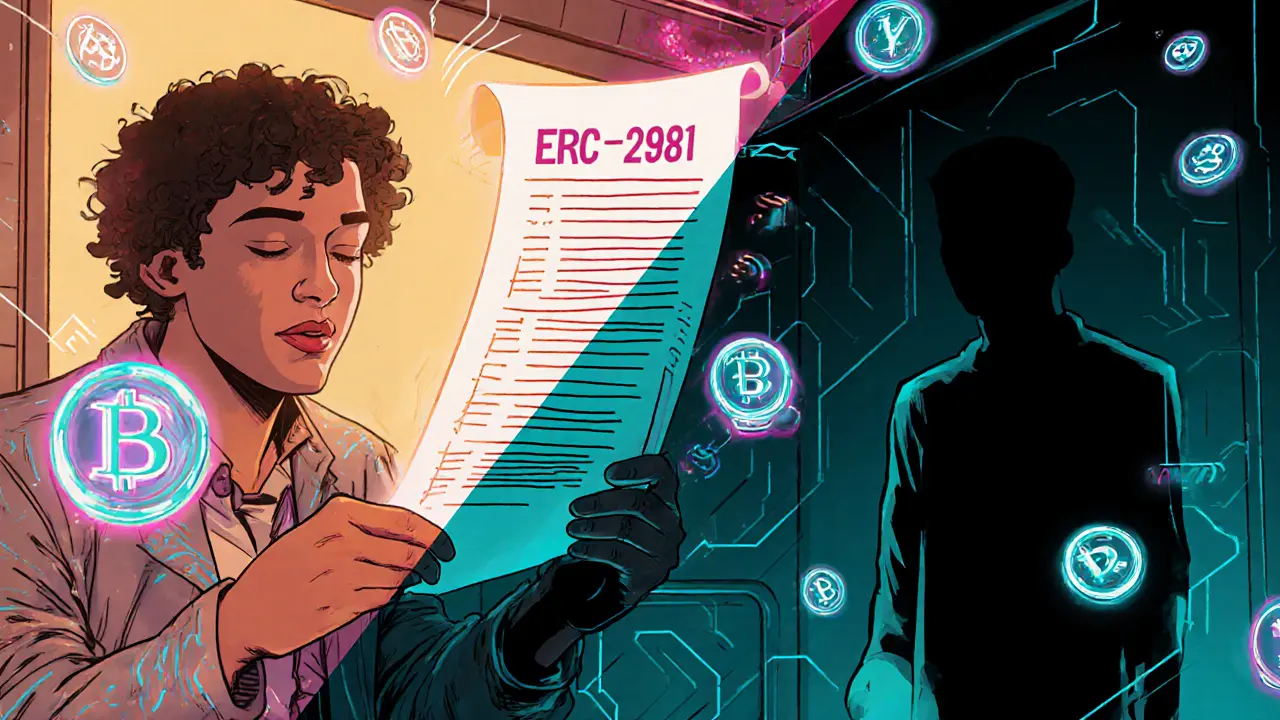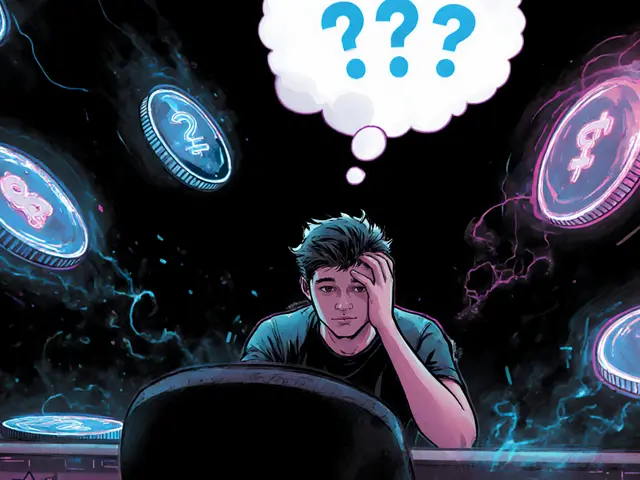NFT Royalty Circumvention Checker
Analysis Results
Ever bought an NFT only to find the artist got nothing from the resale? That’s the reality of NFT royalties today - a loophole that lets traders skip creator payments and leaves artists scrambling for revenue.
TL;DR
- Royalty circumvention stems from optional royalty standards (ERC‑2981) and the open nature of ERC‑721.
- Common tricks include wrapping NFTs in other contracts and off‑market private deals.
- Blocklists stop known bad platforms; allowlists restrict trading to approved venues.
- New standards like ERC721‑C and Hedera‑based fees embed enforcement directly in the contract.
- Creators can protect earnings by using royalty‑enforced token contracts, monitoring marketplaces, and leveraging royalty registries.
What Is NFT Royalty Circumvention?
When an artist mints an NFT, they can embed a royalty percentage that should automatically flow to them each time the token changes hands. NFT royalty is a programmable payment that triggers on secondary sales. Circumvention happens when a buyer, seller, or marketplace deliberately bypasses that payment, sending the full sale price to the counterpart while the creator sees zero dollars.
Why Does It Happen? The Technical Roots
The problem isn’t a legal gray area - it’s baked into the standards. The original ERC‑721 standard defines non‑fungible tokens but offers no royalty enforcement. To fill that gap, the community introduced ERC‑2981 optional royalty interface that marketplaces can choose to honor. Because honoring ERC‑2981 is optional, any platform can simply ignore the royalty field and still transfer the token. This optionality creates the vulnerability that circumvention exploits.
Common Circumvention Techniques
- Wrapping. Traders deposit the original NFT into a new contract (often an ERC‑721 wrapper) that hides the royalty metadata. The wrapper appears as a fresh token with no royalty field, so any sale of the wrapper bypasses the creator’s cut.
- Off‑market private deals. Parties agree to a $0 sale on a compliant marketplace while settling the price off‑chain via a different app, effectively sidestepping the royalty transaction.
- Zero‑fee marketplace listings. Some platforms, like Blur, let creators set royalty percentages to zero, allowing sellers to list NFTs without any royalty distribution.

Marketplace‑Level Circumvention in Action
Take the popular Ethereum marketplace Blur a fast, volume‑focused NFT exchange that offers zero‑royalty options. An artist mints a piece on Rarible with a 5% royalty. A collector buys it, then flips the token on Blur, where the royalty field is ignored. The original creator walks away with nothing, even though the token’s smart contract still contains the royalty definition.
Enforcement Strategies: Blocklists vs. Allowlists
Creators and platforms have tried two opposite tactics to stem the loss.
Blocklists
Think of a blocklist as a firewall. It enumerates contract addresses or marketplace identifiers that refuse to honor royalties. When a user tries to transfer through a blocked address, the blockchain transaction reverts.
Pros:
- Can be retroactively applied to newly discovered bad actors.
- Doesn't require all marketplaces to change their code.
Cons:
- Scalability nightmare - creators must constantly monitor and update the list.
- Bad actors launch fresh contracts that slip through until the list catches up.
Allowlists
Allowlists flip the script: only pre‑approved, royalty‑compliant platforms are permitted to move the NFT. The smart contract checks the caller against the allowlist before approving a transfer.
Pros:
- Guarantees royalty payment on every allowed transaction.
Cons:
- Severely limits composability - the token can’t interact with new apps, games, or DeFi protocols without explicit approval.
- Undermines the open, permissionless ethos that attracted many creators to NFTs in the first place.
Emerging Standards That Embed Enforcement
Because blocklists and allowlists are either too heavy or too restrictive, the community is building standards that bake royalty enforcement directly into the token contract.
ERC721‑C
Developed by gaming studio Limit Break, ERC721‑C extends ERC‑721 with programmable royalty enforcement and transfer restrictions. Key features:
- Creators can whitelist only specific marketplaces; any unapproved contract causes the transfer to revert.
- The royalty amount is locked in the contract, eliminating reliance on optional ERC‑2981 calls.
- Supports “fallback fees” for transfers that happen without a sale, ensuring creators still earn a small amount when tokens are simply moved.
Hedera’s Network‑Level Fees
The Hedera Hashgraph network takes a different route: royalty fees are set at the network layer. When a creator mints an NFT, they define a custom royalty fee and an optional fallback fee. Hedera’s consensus service automatically deducts these fees on every secondary transfer, regardless of which marketplace is used.
This model removes the need for each marketplace to implement royalty logic - the network does it for everyone.
Practical Checklist for Creators
If you’re an artist or project lead, here’s a step‑by‑step plan to protect your royalties today.
- Audit your existing collections. Identify which tokens rely on optional ERC‑2981 and flag them for upgrade.
- Consider re‑minting high‑value works using ERC721‑C or Hedera’s royalty‑enabled contracts.
- Publish a royalty registry entry (e.g., Manifold’s Royalty Registry) with your preferred royalty percentage and default marketplace list.
- Set up a monitoring script (or use a service) that watches for new marketplace contracts interacting with your tokens. Add suspicious addresses to a blocklist.
- Communicate with your community. Explain why you restrict certain marketplaces and how the restrictions preserve long‑term creator earnings.
- Periodically review the allowlist. As new platforms emerge that honor royalties, add them to expand composability without compromising revenue.
Mini‑FAQ
Why does ERC‑2981 not guarantee royalty payments?
ERC‑2981 only defines a standard way for a contract to signal a royalty amount. It does not enforce payment; enforcement relies on the marketplace reading that data and sending the fee. If a marketplace ignores the signal, the royalty is never sent.
Can I block a specific marketplace without rewriting my smart contract?
Only if the token already includes a blocklist or allowlist function (as in ERC721‑C). For plain ERC‑721 tokens, you would need to mint a new collection or use an external registry that marketplaces voluntarily check.
What’s the difference between a blocklist and an allowlist?
A blocklist denies known bad contracts; an allowlist only permits contracts you explicitly trust. Blocklists are reactive, allowlists are proactive.
Are royalties still collectible on Hedera if I sell on an Ethereum marketplace?
Yes. Hedera’s royalty fee is enforced at the network level, not the marketplace. When the token moves across chains via bridges, the Hedera side still triggers the fee before the bridge releases the asset.
Is royalty circumvention illegal?
Most jurisdictions treat it as a breach of contract if the royalty terms are written into the token’s code and the buyer agrees to them. However, enforcement is challenging because blockchain transactions are pseudonymous and cross‑border.

Looking Ahead
The cat‑and‑mouse game between creators and traders isn’t going away. As long as royalty enforcement stays optional, smart contract engineers will keep finding workarounds, and marketplaces will keep tweaking policies to attract volume. The next wave of adoption will likely hinge on standards that combine enforceable royalties with flexible composability - think hybrid models that let a token interact with DeFi or gaming protocols **only after** a royalty check passes.
For creators, the best defense today is to upgrade to royalty‑enforced contracts, stay informed about marketplace policies, and join community registries that amplify collective bargaining power. For developers, contributing to open‑source implementations of ERC721‑C or building cross‑chain royalty bridges will shape the future of a more sustainable creator economy.
When you understand how the loopholes work, you can choose the right tools to close them. The ecosystem is still young, but the groundwork for reliable, on‑chain royalty payments is already being laid - it’s just a matter of who adopts it first.




Marketta Hawkins
April 2 2025Look, the royalty loophole is just another symptom of a broken system that pretends to be decentralised while ignoring the creators. The data shows that most of the loss comes from zero‑royalty marketplaces that simply don’t care. If we want real change, we need to stop pretending that “optional standards” are enough. 🙃
Drizzy Drake
April 4 2025Hey folks, I totally get why this topic feels overwhelming at first, but stick with me and we’ll break it down step by step.
First, remember that royalties were introduced as a goodwill gesture for artists, not as a guaranteed income stream, which is why many platforms treat them as optional.
When you mint an NFT using ERC‑2981, you’re essentially adding a “hint” to the contract that says “hey, give a cut to the creator,” but the blockchain itself doesn’t enforce that hint.
That means any marketplace that decides to ignore the hint can legally move the token without sending the royalty.
This is exactly what happens on zero‑royalty platforms like Blur, where the smart contract still contains the royalty data, but the UI simply doesn’t display or transfer it.
The consequence is that creators lose out on potentially significant revenue, especially on high‑volume trades.
Some developers try to patch this by building blocklists that reject transfers through known non‑compliant addresses, but that approach quickly becomes a cat‑and‑mouse game as new contracts pop up.
Allowlists, on the other hand, guarantee that only pre‑approved markets can move the token, but they also cripple the open nature of NFTs, preventing integration with games or DeFi.
The emerging ERC‑721‑C standard tries to strike a middle ground by baking enforcement logic directly into the token, so even if a marketplace is “friendly,” the contract will revert unless the royalty is paid.
Hedera takes an even bolder step by moving royalties to the network layer, meaning every transfer incurs a fee regardless of the marketplace-this could be a game‑changer for cross‑chain assets.
For creators looking to protect their earnings today, the practical checklist includes auditing existing collections, re‑minting high‑value pieces with enforceable standards, and publishing a royalty registry entry on services like Manifold.
It’s also wise to set up monitoring scripts that alert you to suspicious transfers, allowing you to add new offenders to a blocklist in real time.
Communication with your community is crucial; explain why you’re restricting certain platforms so supporters understand the trade‑off between composability and fair compensation.
Lastly, keep revisiting your allowlist as new platforms emerge that respect royalties, so you don’t lock yourself out of future opportunities.
In short, the battle over royalties is far from over, but with the right tools and a proactive mindset, creators can stay ahead of the curve. 🙌
AJAY KUMAR
April 6 2025It’s a disgrace that the very architects of our digital future have left artists to bleed while profit‑hungry speculators skate by on loopholes – a betrayal fit for the annals of history! In the land of the free, we boast about decentralisation, yet we turn a blind eye as royalty‑free markets like Blur swoop in and strip creators of their rightful share. This is not just a technical glitch; it’s an ideological war where the lax standards of ERC‑2981 become the weapons of the unscrupulous! We must rise, demand enforceable contracts, and show the world that we will not tolerate this cultural theft. 🌟
Shelley Arenson
April 8 2025Absolutely love how this post breaks down the problem – it’s super helpful! 😊 I think more creators should adopt ERC‑721‑C or Hedera to protect their earnings. Let’s keep sharing these tools! 🚀
Joel Poncz
April 11 2025Yea, i totally agree with u. its rly important 2 use those new staandards n stay safe. tho sometimes its a bit confusing 2 figure out wch one fits ur project best. keep up the good work!
Kris Roberts
April 13 2025What strikes me is the philosophical tension between open composability and enforced fairness. On one hand, the genius of NFTs lies in their permissionless nature, allowing endless remixing and integration. On the other, the lack of built‑in royalty enforcement creates a moral hazard that erodes trust. The emerging standards feel like a compromise, embedding a conscience into code without completely shackling creativity. It’s a fascinating evolution, and I’m curious to see how the community negotiates this balance over the next few years.
lalit g
April 15 2025I appreciate the balanced view presented here. While blocklists can be a pragmatic stop‑gap, they inevitably become a game of whack‑a‑mole. Allowlists protect creators but risk stifling innovation. A hybrid approach, perhaps with community‑governed registries, might offer a middle path that respects both creator rights and the open ethos of Web3.
Reid Priddy
April 18 2025Honestly, I think the whole “community‑governed registry” idea is just a Trojan horse for power‑players to control the market. They’ll claim it’s for the good of creators while quietly steering traffic to their own platforms. Keep an eye out for hidden agendas; the consensus is never as pure as it seems.
Shamalama Dee
April 20 2025Great summary! For those just getting started, remember that publishing your royalty information in a reputable registry (like Manifold) adds an extra layer of visibility. It’s a simple step that can deter bad actors and make enforcement easier for compliant marketplaces.
scott bell
April 22 2025Royalties are the price of respect.
vincent gaytano
April 25 2025Sure, if you think “respect” comes with a fee you can just ignore. The crypto world loves to pretend it’s above money while silently siphoning it away.
Dyeshanae Navarro
April 27 2025In simple terms, if we stop giving free rides to lazy marketplaces, creators will finally see the value they deserve. It’s not rocket science; it’s basic fairness.
Matt Potter
April 29 2025Let’s crank up the optimism and push for universal royalty enforcement! If we band together and demand it, the industry will have no choice but to adapt – and that’s a win for everyone.
Marli Ramos
May 2 2025meh, another post about royalties… 🙄👍 but i guess it’s kinda important? lol